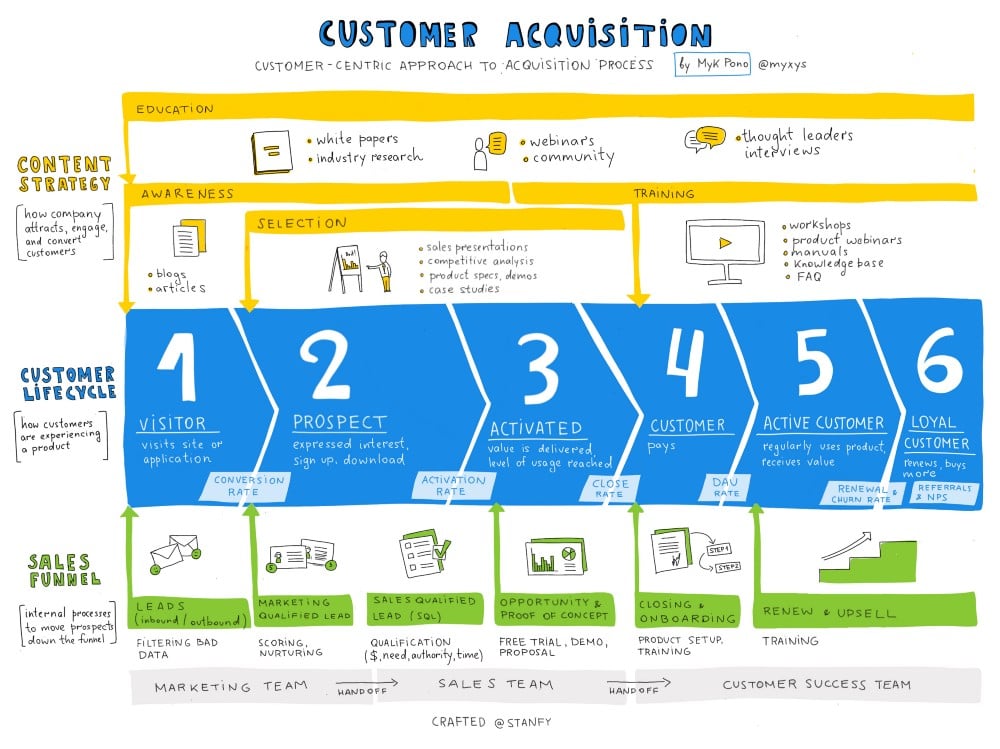The worst things you can do to your customers is to ignore them, make them wait, make them answer their own questions or force them through silly processes that don’t help them solve their problems and make their lives better. Take a moment, here at the end of 2016, and ask yourself, ‘am I customer-centric’?
How did you answer? More importantly, how would your customers answer?
As we transition into 2017, this is a good opportunity for you, for me, for all of us to take a moment and consider how we and our customers could all benefit from a more customer-centric sales cycle.
Customer-Centric Sales
Any sales process you look at was built by a salesperson. It goes with the territory. The main problem here is that most of us salespeople are building these processes thinking about what we need to do to close a sale. We often forget, at our own peril, that the reason the sales process exists is to deliver a superlative customer experience.
Rather than the process, it is actually the customer experience that matters most. And when we pay attention to the customer’s experience first, we can create a sales process centered around customers that qualify, educates, wins, and retains better customers.
Let’s take a deeper look at three elements of a splendid model for customer-centric sales (courtesy of the great Myk Pono) to see how we can improve.
Customer Lifecycle
- The customer lifecycle describes the experiences a customer is having throughout the entire lifetime of their use of a product or service. From start to finish, the lifecycle is defined by the following stages: visitor, prospect, activated the user, customer, active customer, and loyal customer.
Sales Cycle
- The sales cycle describes the sets of actions marketing, sales and customer success teams take to accelerate and elevate the quality of the customer experience throughout the customer’s lifecycle. The sales cycle can be defined by the following set of stages: lead, marketing qualified lead (MQL), sales qualified lead (SQL), opportunity, closed (won or lost), onboarding, upsell/cross-sell.
Content Strategy
- The content strategy defines what type of content and how that content will be leveraged by the marketing, sales, and successful teams at each stage. You will notice that content is not only playing a role in attracting new customers to your business, but rather, it is playing an integral, essential role in the entire customer lifecycle and is used by each customer-facing team in your business, even if you are a team of one.
If we only focused on the needs of our sales team, that would change our sales cycle and the content we create turning our businesses into sales centric organizations. Sales are critical to your business, but it is customer-centric sales that keep our business focused on delivering a great customer experience.
To illustrate these three concepts, there is no better infographic than this from Anna Iurchenko (also from Myk Pono’s ‘How to Track Customer Acquisitions’):
Customer-Centric Content
But wait, you ask, why is content the critical third component here? Why not products or services?
Content is actually the essential component in customer-centric sales because, if we think about the customer’s experience, we need to be educating our customers every step of the way. Take a look at the graphic above.
We want to educate our customers about their pain, their needs, our solutions, how to use our products, to get the most from our services, why we kick butt on the competition, etc. That list goes on and each step of the way is supported by different forms of content serving different purposes for the customer.
The different formats of content we want to create for our customers (not for salespeople) are:
- Blog posts and articles: Help your customers by answering the sort of questions they are actually asking about your industry and the pain points they experience. This is not a sales pitch. The best way to start is to actually interview a customer and let them ask you some questions. You’re an expert, so record your answers. Then maybe have Verblio (formerly BlogMutt) writers turn it into a post or an article for you. This sort of content will build awareness for your business in your industry and show your customers that you understand their pain.
- Webinars, FAQs: As your customers get closer to actually making a decision on a service or offering, they will need to know how the product looks and works. Does it address their pain points? Webinars and FAQs are essential to a consumer’s buying process, and being transparent with these pieces for your audience will build trust above all (and hopefully show off why your product is a good solution in the process, too!).
- Sales presentations, product specs, demos, case studies: As a consumer yourself, you can probably attest that buying something involves weighing the other options out there. If you can present case studies of reviews or comparisons of others on the market, you’ll stay customer-centric.
And as I’ve mentioned before, staying customer-centric is a cycle. You may foster a customer in and convert them, but ongoing education with content is essential to keep in touch with their needs, optimizing the use of your product, and giving the best service you possibly can. Godspeed!





